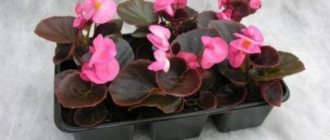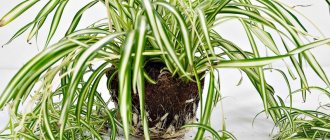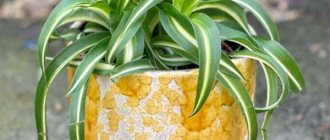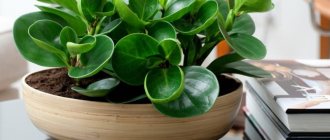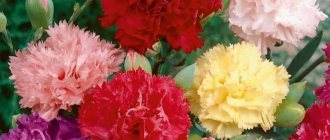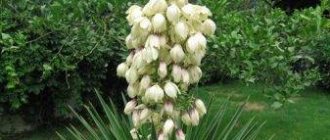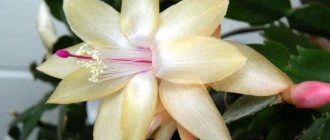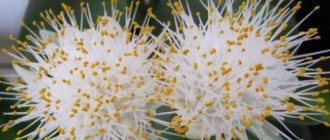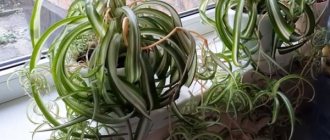In appearance, this indoor flower resembles a large, intensely green tuft of grass and, indeed, in its country of origin it is planted under trees as a ground cover plant. In our country, chlorophytum is grown as a home ornamental plant. It is undemanding, adapts well to environmental conditions, and rarely becomes a victim of pests - this is a good choice for beginning gardeners! In addition, it purifies the air and reproduces easily. From this article you will learn how to grow chlorophytum - care at home, how to propagate it.
Types of chlorophytum
The plant arrived in Europe 200 years ago from the subtropics of Africa and Latin America. This is a flower with stringy roots and a variegated cap of elongated lanceolate leaves of various colors. Of the many plant species, the most common ones should be noted:
- Tufted is a compact but growing bush with leaves growing from the center, resembling a tuft. The middle part of the leaf is pale yellow, the edges are green, in the form of a narrow strip. The flowers are small greenish in color on a high peduncle;
- Curly - the shape and color of the leaves are similar to crested chlorophytum, but they become rounded as they grow, in the form of curls. Therefore, the bush takes on a spherical shape;
- Cape is a simple variety of chlorophytum with leaves of intense yellow color.
- Chlorophytum Blue Pearl is a pearl among flower varieties. Quite unlike a traditional flower, the plant consists of long hanging strands of blue cones located along the entire length of the stem. An unusual and mesmerizing blue waterfall attracts attention.
Main varieties and varieties
All flower varieties have names that fully correspond to their characteristics. Thus, Chlorophytum Comosum, which is translated from Latin as “green plant,” has rich green leaf blades.
Blue pearl
Among the variety of species and varieties, Blue pearls are especially popular, which is rightfully considered the pearl in the huge assortment of chlorophytum. It forms long hanging strands of blue cones along the entire length of the stem. The plant is very similar to a blue waterfall.
Cape
The Cape chlorophytum variety received its name in honor of the South African province where it was bred. This perennial rosette-type grass is distinguished by long leaves up to 60 cm, their width is 3 cm. They are painted light green, and the cuttings are dark orange.
Caring for chlorophytum at home
Chlorophytum is one of the flower crops that can be cared for by a novice gardener. Watering, fertilizing and annual replanting are the main stages of year-round care for chlorophytum.
You can place the flower anywhere in the room, but it grows best on western and eastern windows. The color of the leaves and their elasticity will be more intense. But if you place a pot with a flower in a darker place, it will also grow and bloom, only less actively.
Watering
If you often travel or forget to water your plants, chlorophytum is an ideal specimen for your apartment. Its roots absorb moisture and retain it for a month. Watering should be regular and moderate. Periodically spray the leaves, give your pet a shower and wipe the leaves of the flower from dust with a sponge or cotton wool soaked in water. The plant will respond to care with brightly colored leaves and flowering.
Top dressing
Like any plant, chlorophytum needs nutrients for growth and development. Any complex mineral fertilizer for decorative foliage plants or universal fertilizer for indoor flowers, used in accordance with the instructions, will be beneficial. In summer it is enough to feed once every 10-13 days, in winter - once every 25-30 days.
Trimming
The flower does not require special pruning, except for removing diseased and old leaves. If you want to shape the crown or remove a cascade of rosettes, you can trim periodically. Although, descending small rosettes of chlorophytum give the flower beauty and elegance, and perhaps some playfulness.
Transfer
It is better to replant an adult plant in the spring into a spacious pot, since under normal conditions the flower develops quickly and builds up the root system and green mass.
Description
If you find a plant in the search engine of the main online identifier - Plantarium, then it will give an unambiguous answer to the query:
- department - Magnoliophyta (Floral, magnoliophytes);
- class - Liliopsida (Lilyaceae);
- order - Amaryllidaceae (Amaryllidaceae);
- family - Asphodelaceae (asphodel or asparagus).
This classification means that the plant is a close relative of amaryllis and asparagus. In principle, if you carefully examine the chlorophytum flower, it will become clear why. Indeed, it is very similar to the beautiful amaryllis. Only in miniature.
Despite the fact that Africa and India can be considered the homeland of amaryllis, chlorophytum feels great in other countries. In Western Australia, South America, and more recently in Crimea, Montenegro, and everywhere where winters are not so severe, there are white-green bushes that produce many small rosettes spreading in different directions.
Biological properties and appearance
All types of chlorophytum, and there are many of them (there are up to 200), are basically similar. A few of the most common are:
- Chlorophytum crested;
- chlorophytum curly;
- Chlorophytum cape;
- chlorophytum orange;
- Chlorophytum laxum.
All of them are perennial herbaceous plants, in nature they are not very tall, they have almost no stems, since they form basal rosettes close to the ground. Strong and thin rhizomes reliably hold the bush, large tubers on the roots nourish the flower with accumulated moisture and microelements dissolved in water.
The leaves of the plant do not have petioles, they are sessile (some species have a very short, almost imperceptible petiole, but still the leaf blades are pressed tightly against each other). The long, linear leaves vary in color among different species, but almost all have variegated stripes that greatly decorate the rosettes.
They bloom gently, not very brightly, but quite often, under good conditions even several times a year. They produce fruits, but the main method of reproduction is children. Tiny rosettes, from which small roots grow very quickly, take root easily, forming a continuous, beautiful carpet around the plant.
Reproduction of chlorophytum
Chlorophytum is one of those plants that easily reproduce and take root. The easiest way is propagation by rosettes. Small, cascading rosettes need to be carefully cut off and placed in water. After some time, the rosette will give roots, and it can be transplanted into containers for seedlings.
If the flower bush has grown, you can propagate it by dividing the bush. Dividing the bush must be done carefully so as not to damage the numerous roots. You can also propagate the plant by crown rosettes, which grow separately a little further from the main rosette. Rosettes with roots must be immediately planted in the soil and watered.
If you want to breed rare varieties of plants, you can purchase seed material, soak it for a day in a growth stimulator and sow it on the surface of the soil. Moisten the soil by spraying and place in a mini-greenhouse (plastic bag). As the seedlings appear, remove the greenhouse, and in the phase of 2-3 leaves, pick the seedlings into separate containers.
Choosing a container for planting
An ornamental plant should be planted only in a spacious, large container. Chlorophytum has large, massive and branched roots that require sufficient space. During the first few years of active growth, it is necessary to replant the bush and change the pot.
When choosing a flower pot for replanting, you need to take into account that its diameter should be 4-6 cm larger than the previous container. The best option would be a fairly wide but low flowerpot in which the rhizome could grow in breadth. A pot that is too narrow and cramped can lead to a decrease or complete cessation of flowering.
Clay containers are not used for ornamental plants. This material allows moisture to evaporate very quickly, and constant soil moisture is important for chlorophytum. Chlorophytum is a hanging plant, so it can be planted in hanging flowerpots as an interior decoration.
The magical properties of chlorophytum
Taking care of the owners is the main magical property of a flower. Absorbing all negative substances and cures, eliminating negative energy and cleansing the aura of the house, it brings health, mood, comfort, peace and tranquility to its inhabitants.
There is no family whose apartment window sills are not decorated with indoor flowers. Some people love plants that bloom profusely, while there are others who prefer evergreen beauty. Chlorophytum, whose stems hang majestically along the edges of flowerpots, will be an excellent decorative element of any living space. They themselves choose a suitable place for themselves in the new premises. There is a legend according to which the house will be full, with prosperity, prosperity, love, fidelity, mutual understanding, if you add chlorophytum to it first. It has such powerful energy that it is enough for all family members. In order for a flower to share its positive aura with others, you need to take good care of it.
Signs and superstitions
Chlorophytum was popularly dubbed “family happiness.” There is an opinion that this indoor flower responds to the surrounding energy. If a plant, even with proper care, withers and disappears, this indicates an unfavorable environment. When a flower looks well-groomed and healthy, it means that mutual understanding and happiness reign in the house.
The rapid growth of a flower promises the owner quick success and possible favorable changes in his personal life.
Also, it is often compared to a spider's web. It is believed that it is a barrier, delaying the negative impact that appears on its owners.
Many positive magical properties are attributed to chlorophyte. It brings happiness, good luck, helps improve destiny, protects peace and well-being in the family, calms, and smoothes out conflicts. And these are not all the qualities that people have endowed with this unique flower.
More details about chlorophytum in the video:
Features of the flower
This plant is considered one of the most popular, preferring indoor conditions. It is very decorative and unpretentious. It is native to South Africa, where it can be seen hanging from the bark of trees. It somewhat resembles a bush with shortened stems and thickened roots, sometimes tuberous in shape. The plant is a perennial species. It reaches about half a meter in diameter, although meter-long specimens can be found in the wild. Tuberous thickened roots help the plant withstand prolonged drought.
Growing a plant from seeds
There are several ways to propagate a flower: by seed and by cuttings. The latter method is faster and less labor-intensive. But experts recommend using seed material, since the growing process itself becomes exciting.
In order for the seeds to produce a beautiful flower, they must be of high quality and meet certain requirements, such as:
- be large in size;
- have an oval shape;
- have a length of at least 2 centimeters;
- covered with a thin fleshy shell;
- their shelf life should not exceed six months.
Chlorophytum winged is mainly propagated by seed, because it practically does not throw out rosettes. Other species reproduce by shoots or division of the bush. Seeds are sown in sand or peat at the end of winter - beginning of spring. But first they must be soaked for a day. Before planting, the soil mixture is moistened. Seeds are laid out on its surface at an equal distance from each other. The seed material is pressed into the ground with little force. The container is closed with a plastic bag or glass. In order for the seeds to germinate quickly, they need to create a soil temperature of about 21 degrees.
The first shoots will appear in 20 - 25 days. It may take a month and a half. Young shoots should be sprayed regularly and the room should be ventilated to the desired temperature. As soon as the seedlings have 2-3 leaves, they are transplanted into a separate small pot. After the seedlings have grown, they can be planted in fertile soil in the garden.
Helpful information. To store seed material, it is advisable to choose a room that is dark, cool, and with a humidity level of 60%. High temperatures and direct sunlight negatively affect the quality of seeds.
Rules for planting and replanting a flower
Young chlorophytums grow very quickly, so they need to be replanted every year. Spring is chosen for these actions. In adult plants, growth slows down, so you should not replant them so often, but only as needed. This can happen after 3 years, after the flower has grown strongly.
As soon as the tips of the roots begin to peek out from the drainage hole or the plant has stopped growing and blooming, then it is worth taking care of a new, larger container. The roots of chlorophytum grow not only in length, but also in width. Therefore, the pot itself should not be so deep as it should be wide, seven centimeters wider than the previous version.
It is good to use ceramic containers. All pots must have drainage holes. Otherwise, you need to do them yourself. The roots should not be constantly in water, they may get sick.
Chlorophytum does not need special soil. It grows and develops well in ordinary store-bought soil. But the acidity indicator is of no small importance. The best option is neutral acidity. Acidic and alkaline soil should be excluded. If you prefer to prepare the soil mixture yourself, then you need to have the following ingredients available:
- leaf soil (2 parts);
- turf soil (2 parts);
- humus (1 part);
- coarse sand or perlite (1 part).
Instructions for replanting chlorophytum
It is quite simple, but it must be followed to obtain a positive result:
- Select a container and place drainage 2cm high on the bottom. The earth is poured on top.
- The socket is carefully pulled out of the old pot, without haste, with both hands. In order not to damage the root system, you should not pull it up, but swing it from side to side.
- As soon as the rosette is removed, the old soil is slightly removed from its roots.
- Chlorophytum is installed in the middle of a new pot and a little fresh soil mixture is added there.
- Once the planting procedure is completed, the plant is watered heavily. Any water that gets into the pan is removed. The container is placed in a place where partial shade is constantly present. This is necessary so that the flower quickly gets used to new conditions.
Flower care rules
It is better to choose a window sill with good lighting for chlorophytum. Partial shade may also work. In the presence of excessive shade, the leaves of the flower become dark green in color and their variegated stripes disappear.
The plant can develop both in a warm room and in a slightly cool place. In winter, it tolerates temperatures of 11-13 degrees well. But under this condition, the periods between waterings should be increased. Otherwise, the leaves may wrinkle and brown spots appear on them. At excessively high temperatures (over 22 degrees) and lack of proper lighting, the leaves may become pale, turn yellow and fall off.
If the air in the room is dry, it will not become an obstacle to the development of chlorophytum. But excessive, prolonged dryness can negatively affect the condition of the leaves. They may turn brown and dry out. Then it’s worth cutting off the damaged areas so as not to spoil the beauty.
During the entire growing season (spring - autumn), the plant requires abundant watering. In hot weather, the leaves should be sprayed with water. In winter, the amount of watering is reduced. During spring and autumn, complex fertilizers intended for indoor plants must be added to the flower pot.
Chlorophytum is practically not afraid of diseases and pests. But if the specimen is weakened, then it can be overcome by aphids or spider mites, and very rarely by scale insects and scale insects. If possible, the plant can be left outside in the summer. But you need to choose a place where there are no drafts or direct sunlight.
Types, varieties, names with photos
Nature has created hundreds of varieties of chlorophytum, but its original appearance did not attract human attention. However, breeders were able to domesticate several species and their varietal variations became masterpieces among deciduous ornamental plants.
Chlorophytum Crested / Chlorophytum Comosum
In its natural environment it is represented by a small herbaceous shrub with drooping grassy foliage of a pale green color.
Chlorophytum comosum Variegatum
Decorative varieties based on this species:
- Chlorophytum Vittatum
- Chlorophytum Variegatum
- Chlorophytum Maculatum
- Chlorophytum Curty Locks
Chlorophytum Capense
A natural feature of this species is the foliage elongated into a thin oval. At the base of the rosette the leaf is thin, but widens towards the end. Color: light green.
Chlorophytum Bonnie
A very small but exquisite piece. Its thin long blades of grass are twisted into a spiral, and a bright white stripe is drawn along the green background of the leaf plate.
Chlorophytum Winged or Chlorophytum Orange / Chlorophytum Amaniense
The leaves are wider than those of other species and grow on short orange petioles. The foliage is dark green in color.
Green Orange
Varietal types:
- Chlorophytum Green Orange
- Chlorophytum Fire Flash
Flower damage by pests and diseases
If you properly care for the plant, it will delight you for quite a long time and decorate your home. Possible damage by nematodes, thrips, mealybugs, and aphids. To combat these pests, effective spraying agents have been developed, such as Fitoferm and Actellik. For prevention purposes, you can use fertilizer with fungicides “Sakhalin sodium humate”.
The main problems with diseased flowers, which can be recognized upon careful examination:
- the tips of the leaves become brown and dry out (a consequence of excessive dry air and lack of nutrients);
- if the soil is clayey, then in case of heavy watering the rosette of leaves begins to rot;
- paleness of the leaves appears, which indicates strong darkening or incorrectly selected temperature conditions;
- If the leaves turn dark green, then they lack sunlight. On long cloudy days, it is good to place the pot under a fluorescent lamp;
- If yellowness appears on the leaves, then it is worth reducing the amount of watering. It is advisable to transplant these plants into new soil. Yellowness can also be a sign of a small pot or lack of nutrients.
If a plant is damaged by scale insects, brown spots appear on the surface, and the plant dries out over time. Scale insects are removed using Actellik solution, which is sprayed. If you miss time, sooty fungus will begin to develop, which causes the death of chlorophytum. When a spider mite appears, the leaves wither and cobwebs can be seen in the internodes. Spider mites develop well in dry air. They fight it with the same drug as for scale insects.
A good environment for thrips to appear is excessive humidity. Naphthalene can control this pest. A small number of balls are taken and placed in close proximity to the plant. Karbofos, which needs to be sprayed on the leaves, helps in the fight against mealybugs.
To prevent the plant from getting sick, it is necessary to maintain the correct temperature in the room, sufficient humidity and good lighting. If the disease does affect the flower, then the leaves must be treated with a soapy solution using a soft sponge. Then the leaves are washed under running warm water. Afterwards they should be treated using special chemicals.
And finally, some video information about chlorophytum:
Among the beautifully flowering houseplants, a decorative foliage flower, chlorophytum, takes pride of place, the varieties of which number almost 250 specimens. It is chosen for its unpretentiousness to living conditions and high decorative properties. This hardy herbaceous plant is moisture-loving and shade-tolerant. It is capable of forming green fluffy bushes in a short time. To make it easier to navigate the varieties and types of chlorophytum, it is recommended to consider the most common of them.
On a note
The houseplant does not attract parasites and midges, which are typical for other houseplants. It does an excellent job of purifying the air from harmful accumulations:
- bacteria, bacteria
- gases,
- toxins and other substances.
If you water frequently but moderately, the air in the room will become noticeably humidified.
Chlorophytum has amazing and unique beneficial properties:
- Removes excess impurities and gases from the air: benzene, acetone, carbon monoxide and others.
- Helps with attacks of bronchial asthma.
- Has a positive effect on the condition of people with allergies.
Origin and botanical description of the plant
Chlorophytum is native to South Africa and is also found in South America. In its natural environment, the plant lives on tree branches, holding onto the bark. This perennial is one of the most important components of forest cover.
The height of chlorophytum does not exceed 1.5 m. It has practically no stem; the growth of basal leaves begins from the ground. The root system is a collection of white thin cord-shaped shoots, rooting of which occurs due to elongated tubers. It is in these tubers that life-giving moisture accumulates, saving the plant during periods of drought.
The first description of what chlorophytum looks like was recorded in 1794. It came to Europe at the end of the 19th century, where, thanks to its useful and decorative qualities, it quickly gained recognition among floriculture lovers.
The leaf blades of this heat-loving bush are formed of a linear type, they have a smooth surface, bright green or variegated color. On average, their length is 15-60 cm. A stringy core is clearly visible in the center of the plate.
There are specimens with short-petioled or sessile leaves. Flowers appear in the summer season. At home, chlorophytum is able to delight its owners with repeated flowering. The formation of buds occurs in the nodes, in the place of which, after they fade, children begin to appear. After some time, aerial roots form from the rosette, which, upon contact with the ground, immediately take root. The fruits of the crop are presented in the form of dry, oblong-shaped boxes, inside of which there are three sections with seeds.
When chlorophytum is kept in the room, a favorable microclimate is created; instead of dry air, freshness is felt. In addition, it has an antiseptic effect, fighting pathogenic microorganisms around itself. Thanks to the phytoncides that it contains, it is possible to purify the air from tobacco smoke, carbon monoxide, and formaldehyde.
When and how does Chlorophytum bloom?
The absence of flowers can be for two reasons:
- insufficient lighting;
- untimely transplantation.
The vegetative period of the plant is active, very rarely when the flower does not bloom for a long time
Replanting is necessary to renew the soil by transferring it to a larger pot.
During replanting, it is important to inspect the roots and remove all damaged ones, as they accumulate moisture and there is a high risk of shoots rotting. Also, sometimes the tips of the leaves begin to turn black, which is also a sign of overwatering of the plant.
Usually, after a spring transplant, two weeks later the plant produces the first arrows of flower stalks. An indicator of a healthy plant will be the thickness and length of this shoot.
Note! If the plant feels comfortable, it produces flower arrows throughout the active growth period - from spring to winter. Different varieties bloom differently, but they are all united by the ugliness of the flowers.
Chlorophytum is a deciduous ornamental plant that is not a beautiful flowering plant.
Different varieties bloom differently, but they are all united by the ugliness of their flowers. Chlorophytum is a deciduous ornamental plant that is not a beautiful flowering plant.
- Chlorophytum cape does not bloom at home at all. It reproduces by dividing the root and by children that grow directly on the rosette of the flower.
- Striped and crested chlorophytums produce long shoots on which snow-white flowers with yellow stamens are arranged in a spiral. They are cute, but inconspicuous compared to the green fountain of lush greenery. After flowering, small bushes of children appear at the tips of the shoots of curly chlorophytum. They soon acquire aerial roots and can live on their mother shoots for a long time. Crested varieties grow babies from leaf axils.
- Exotic and unusual varieties of chlorophytum, such as Orange, Laxum and chlorophytum Ocean or Ocean, bloom with unusual spikes of light yellow or greenish flowers.
This interesting spikelet appears as if from a new leaf, which envelops it until the end of flowering
Chlorophytum is ideal for beginner gardeners and is loved by experienced plant breeders. Its unpretentiousness and decorativeness have won the love of designers who use these green fountains in compositions in the open ground. In the home, this herbal friend will be beneficial in purifying the air and with a minimum of hassle in care.
Features of caring for different types
Chlorophytum is positioned as an undemanding plant; it is able to grow and develop in the shade and with a lack of moisture. But in order to maintain its high decorative qualities, it needs to be provided with appropriate care at home:
- Bright daylight . The better the lighting, the more lush and green the exotic crop, but it is not recommended to allow direct exposure to sunlight on the leaves of the flower. Otherwise, they will get burned. If there is a lack of sunlight, the plant will not wither, only its color will fade and growth processes will stop. It is recommended to place the flower pot near a window or in partial shade.
- Optimal temperature conditions . For chlorophytum, the temperature in the warm season should be +25 °C, and in winter - +20 °C. Do not allow the temperature to drop below +10 °C.
- High humidity. Dry air is contraindicated for exotic flowers. He needs regular spraying and bathing. Otherwise, the tips of the leaves will begin to dry out. In winter, it is not advisable to place a flower pot near heating appliances.
- Suitable container. If the pot is too large, then instead of growing the above-ground part, the plant will direct all its forces to filling the container with roots.
- Optimal timing for planting, transplanting and propagation. These manipulations should be performed in February or March. A young bush is replanted every year, and an adult one – once every 2-3 years.
- Proper organization of the irrigation system. Irrigation measures should be carried out when the earthen ball is half dry. Do not worry that the plant lacks moisture; it accumulates in the tubers of the rhizome. In addition, you should ensure that there is no stagnation of moisture in the pot and tray.
- Soil substrate. The soil for chlorophytum should be neutral or slightly acidic. It should contain two parts of turf soil, one part of leaf soil, one part of sand, one part of crushed pine bark.
- Nutrition. Feeding procedures should be done using a mineral complex fertilizer for deciduous plants. The frequency of procedures is 1-2 times a month, in March-August.
Growing in city apartments: basic rules
Today, caring for chlorophytum at home is considered the easiest; this plant forgives its owner most mistakes, although this does not mean that it will grow on its own. It is best to keep the crested exotic at room temperature at +18°C. It can still tolerate minor changes, but temperatures that are too high or too low can cause brown spots to form on the leaves. It is imperative to protect it from drafts.
- The most optimal location is western, eastern, and southern windows.
- It would not be superfluous to create a screen of tulle to protect from direct rays of the sun.
- It is not recommended to keep the decorative inhabitant in constant shade, as the color of the leaves will lose its brightness and attractiveness.
- Watering is divided by season: spring-autumn - abundant moisture, but in winter the amount of water must be reduced.
- Spraying is carried out only if this hardy creature is standing near heating radiators.
- He doesn't need excessive dry air.
- Feeding is carried out from March to August after one week or two.
Transplantation and subsequent propagation
Chlorophytum is replanted every year or two; the best time for this is February and March. To replant, you need to take a substrate consisting of 1 part leaf soil, one part humus, sand and two parts turf soil. They need to be replanted in spacious flowerpots with good drainage at the bottom. Chlorophytum reproduces by children and division, while the children are simply separated from the peduncle and take root in ordinary soil.
Chlorophytum diseases
Chlorophytum is an unpretentious creature; it can grow well in almost any conditions, which makes it a fairly frequent guest in apartments. It is also valued for its resistance to various diseases and pests. But this does not mean that the indoor chlorophytum flower does not need care and constant monitoring.
It is worth paying attention to a few of the most common problems
- The tips of the leaves turn brown due to improper and insufficient watering, improper feeding, or sudden changes in temperature in the room where it is kept. If this happens, you must immediately find out the cause of this condition, then take appropriate action, for example, provide more frequent watering or start feed.
- The leaves may not be as bright if there is insufficient lighting or the pot for the plant is too cramped. In this case, it is recommended to place the pot in a well-lit place. If this does not help, then transplant the plant into a spacious pot.
- Leaves can become pale and soft not only when there is insufficient lighting, but also when grown in a room that is too hot. Sometimes they even begin to fall sharply. It is recommended to lower the temperature and move it to a more illuminated windowsill.
Chlorophytum, which is easy to care for, can sometimes be affected by certain types of pests. Most often these are scale insects, spider mites. As a result of the damage, the leaves begin to dry out and then fall off as insects feed on the sap of the plant. In this case, you need to inspect the foliage, remove insects with a soapy sponge, and treat the crown and stems with systemic insecticides.
Growing lilacs or any other garden plant is also not without pest invasion. If they are detected in time and treated appropriately, there will be no particular damage to the plant. The stone rose is much more hardy in this regard; it is not afraid of pests, drought and other garden misfortunes.
Possible difficulties during cultivation
In general, chlorophytum has increased immunity to pathogenic microorganisms and harmful insects. Only in case of violations in care can negative consequences such as:
- Root system rotting. The plant has a wilted appearance and brown stripes begin to form on the leaf blades. Such problems arise when there is excess moisture in the soil and a lack of sunlight. In order for the plant to recover, you need to cut off its rotten sections of the root system, treat them with charcoal and replant them in new soil.
- Drying of leaf tips. The problem appears due to dry air, high levels of humidity in the soil and stagnation of water in the pot, as well as a high concentration of nitrates in the soil mixture. The situation can only be corrected by changing the soil to light soil and placing a container of water near the flower.
- Faded stripes on leaf blades. Fading of leaves appears in case of lack of sunlight and nutrition. To help the plant, you need to move the flower pot to a sunny place.
- Drying of leaves at the roots. To eliminate the problem, you need to increase the frequency of irrigation and spraying.
- Brown spots on leaves . The disease manifests itself in excess light, so it is recommended to place the pot in a shaded place.
- Harmful insects. It is effective to use a soap solution to wipe the leaves against aphids, nematodes, mealyworms and thrips.
Chlorophytum occupies one of the leading positions in home floriculture. He is undemanding, feels quite normal in partial shade, and his appearance leaves no one indifferent. The main thing is to initially create comfortable growing conditions for the flower, and not forget about the basic rules of agricultural technology.
- Author: Maria Sukhorukikh
Rate this article:
- 5
- 4
- 3
- 2
- 1
(0 votes, average: 0 out of 5)
Share with your friends!

